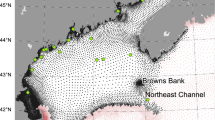Abstract
239, 240Pu,137Cs and90Sr concentrations were determined in sea waters from the central and western North Pacific in 1980 and 1982. The results are consistent with those reported earlier for North Pacific waters. The profiles of90Sr and137Cs show a monotonic decrease with depth, whilst239, 240Pu shows a distinct subsurface maximum at a depth between 400 and 1,000 m.
The calculated inventories of these nuclides significantly exceed the global mean fallout inputs for these latitudes. This may be due to local fallout input to the ocean at times of large-scale nuclear weapon tests in the equatorial North Pacific.
The existence of measurable amounts of137Cs and239, 240Pu in deep waters suggests that these nuclides are transported by sinking particulate matter from the surface to the deep ocean.
Similar content being viewed by others
References
Bowen, V.T., H.D. Livingston and J.C. Burk (1976): Distribution of transuranium nuclides in sediment and biota of the North Atlantic Ocean. In: Transuranium Nuclides in the Environment, IAEA, Vienna, pp. 107–120.
Bowen, V.T., V.E. Noshkin, H.D. Livingston and H.L. Volchok (1980): Fallout radionuclides in the Pacific Ocean; Vertical and horizontal distributions, largely from GEOSECS stations. Earth Planet. Sci. Lett.,48, 411–434.
Fowler, S.W., S. Vallestra, J. LaRosa and R. Fukai (1983): Vertical transport of particulate-associated plutonium and americium in the upper water column of the Northeast Pacific. Deep-Sea Res.,30, 1221–1233.
Horibe, Y. (1983): Preliminary Report of the Hakuhō Maru Cruise KH-80-2 (CYGNUS Expedition) April 25–June 18, 1980 and the Hakuhō Maru Cruise KH-82-1 (CEPHEUS Expedition) January 22–March 17, 1982. Ocean Research Institute, Univ. of Tokyo, Tokyo, 78 pp.
Horibe, Y., K. Taira, T. Teramoto, H. Tsubota, S. Imawaki, K. Kodama and H. Igarashi (1977): Development and recovery of moored arrays of instruments, large-volume sampler, auto-analyzer. In: Environmental Marine Science, ed. by Horibe, Y., Univ. Tokyo Press, Tokyo, pp. 184–208.
Kupferman, S.L., H.D. Livingston and V.T. Bowen (1979): A mass balance for137Cs and90Sr in the North Atlantic Ocean. J. Mar. Res.,37, 157–199.
Livingston, H.D. and R.F. Anderson (1983): Large particle transport of plutonium and other fallout radionuclides to the deep ocean. Nature,303, 228–231.
Michel, R.L. and H.E. Suess (1975): Bomb tritium in the Pacific Ocean. J. Geophys. Res.,80, 4139–4152.
Miyake, Y. and Y. Sugimura (1976): The plutonium content of Pacific Ocean waters. In: Transuranium Nuclides in the Environment, IAEA, Vienna, pp. 91–105.
Nakanishi, T., M. Yajima, M. Senaga, M. Takei, A. Ishikawa, K. Sakamoto and M. Sakanoue (1984): Determination of Pu-239, 240 in sea water. Nucl. Instr. and Meth. 223, 239–242.
Nagaya, Y. and K. Nakamura (1970): A study on the vertical transport of90Sr and137Cs in the surface waters of the seas around Japan. J. Radiat. Res.,11, 32–43.
Nagaya, Y. and K. Nakamura (1976):90Sr and137Cs contents in the surface waters of the adjacent seas of Japan and the North Pacific during 1969 to 1973. J. Oceanogr. Soc. Japan,32, 228–234.
Nagaya, Y. and K. Nakamura (1981): Artificial radionuclides in the western Northwest Pacific (I)90Sr and137Cs in the deep waters. J. Oceanogr. Soc. Japan,37, 135–144.
Noshkin, V.E. and K.W. Wong (1980): Plutonium mobilization from sedimentary sources to solution in the marine environment. In: Marine Radioecology, OECD-NEA, Paris, pp. 165–178.
Östlund, H.G. and R.A. Fine (1979): Oceanic distribution and transport of tritium. In: Behaviour of Tritium in the Environment, IAEA, Vienna, 303–314.
Roether, W. (1974): The tritium and carbon-14 profiles at theGeosecs I (1969) andGogo I (1971) North Pacific stations. Earth Planet Sci. Lett.,23, 108–115.
Sholkovitz, E.R. (1983): The geochemistry of plutonium in fresh and marine water environment. Earth-Sci. Rev.,19, 95–161.
United Nations Scientific Comittee on the Effects of Atomic Radiation (1977): Radioactive contamination due to nuclear explosions. In: Sources and Effects of Ionizing Radiation, 1977 Report, United Nations, New York, pp. 115–164.
United Nations Scientific Comittee in the Effects of Atomic Radiation (1982): Exposures resulting from nuclear explosions. In: Ionizing Radiation: Sources and Biological Effects, 1982 Report, United Nations, New York, pp. 211–248.
Author information
Authors and Affiliations
Rights and permissions
About this article
Cite this article
Nagaya, Y., Nakamura, K. 239, 240Pu,137Cs and90Sr in the central North Pacific. Journal of the Oceanographical Society of Japan 40, 416–424 (1984). https://doi.org/10.1007/BF02303068
Received:
Revised:
Accepted:
Issue Date:
DOI: https://doi.org/10.1007/BF02303068




